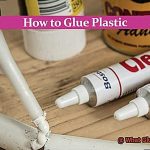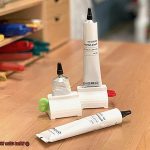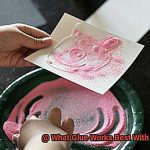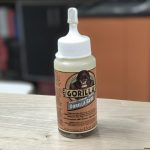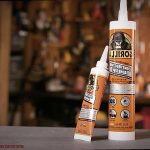Kids and their wild imaginations, right? But what happens when their curiosity leads them to take a bite out of a glue stick? Don’t panic just yet. In this blog post, we’re diving into the captivating world of glue stick consumption to uncover the truth about what really happens when a kid decides to snack on one. So grab your detective hats and let’s solve the mystery together.
First things first, let’s establish that glue sticks are generally safe for kids. They’re specially formulated with materials that won’t cause any major harm if accidentally ingested. However, that doesn’t mean there aren’t any consequences. So, get ready to explore the potential physical and psychological effects of this sticky situation.
Physical Implications:
Contents
- 1 What is a Glue Stick?
- 2 Are Glue Sticks Safe for Children?
- 3 What are the Potential Dangers of Eating a Glue Stick?
- 4 How Can We Prevent a Child from Eating a Glue Stick?
- 5 What Should I Do if My Child Ingests a Glue Stick?
- 6 What are the Symptoms of Ingesting Non-Toxic Glue Sticks?
- 7 What are the Symptoms of Ingesting Toxic Glue Sticks?
- 8 How is Toxic Glue Stick Poisoning Treated?
- 9 Conclusion
Glue sticks are made up of adhesive polymers suspended in solvents, which makes them perfect for arts and crafts projects. Eating a small amount is unlikely to cause any harm, but gobbling up large quantities or making it a habit can lead to some tummy troubles. Think stomach discomfort, nausea, and maybe even a not-so-pleasant date with the porcelain throne. The stickiness of glue might also cause temporary digestive blockages, though it’s pretty rare.
Psychological Effects:
Now let’s dive into the fascinating world of psychology. Some kids who munch on non-food items like glue sticks might be dealing with something called pica. It’s not just a fancy word for eating strange things; pica is actually a condition where people crave substances lacking nutritional value. It could be due to emotional issues or nutritional deficiencies that need proper attention from healthcare professionals.
But wait, there’s more. Unintentional glue stick consumption might also spark anxiety or fear in kids because they worry about the potential harm they’ve caused themselves. It’s important for parents and caregivers to handle these situations with reassurance, explaining that while it’s not the best snack choice, they’ll be just fine.
Conclusion:
So, there you have it. While eating a glue stick isn’t exactly recommended, it’s not the end of the world either. Most of the time, kids might experience some tummy discomfort or minor digestive issues that will pass. Just remember to keep an eye on them and make sure they’re safe. And hey, maybe this whole adventure will teach them to stick to more appetizing snacks in the future.
What is a Glue Stick?
Glue sticks are an essential tool in crafts, school projects, and everyday tasks. With their quick, clean, and reliable bonding capabilities, glue sticks have become a go-to adhesive option. In this article, we will explore the nature of glue sticks, their components, application methods, versatility, and address safety concerns related to their use.
What is a Glue Stick?
- Glue sticks are solid forms of glue enclosed in twistable tubes, resembling lipstick containers.
- They consist of synthetic polymers, typically polyvinyl acetate (PVA), which provide adhesive properties.
How Does it Work?
- The user twists the tube to expose the glue stick and rubs it onto the desired surface.
- Friction from rubbing causes the solid glue to melt slightly and adhere to the material.
- This simple process ensures mess-free application and precise bonding.
Versatility and Usage:
- Glue sticks come in various sizes and formulations tailored to different applications.
- Specific glue sticks cater to paper and cardstock, while others work on fabric, wood, plastic, ceramics, and more.
- Choosing the appropriate glue stick for each project ensures optimal adhesion.
Safety Concerns:
- Most glue sticks are non-toxic and safe for use by children.
- Reading labels or consulting manufacturers is crucial to verify non-toxicity.
- Accidental ingestion of small amounts of non-toxic glue stick typically poses no serious harm.
- Ingestion of large amounts or toxic glue sticks requires immediate medical attention.

Prevention:
- Supervision during arts and crafts activities is vital to prevent accidents.
- Educating children about the risks of ingesting non-food items is essential.
Are Glue Sticks Safe for Children?
Glue sticks, those mighty superheroes of the crafting world, offer quick and clean bonding powers that make them a go-to adhesive choice for all sorts of projects. But as a parent or caregiver, you may be wondering, are glue sticks safe for children to use? Let’s dive into the research and explore the potential risks.
First and foremost, it’s important to note that glue sticks are generally considered safe for children. They are non-toxic and made from ingredients that pose no harm when ingested in small amounts. The main ingredient in glue sticks is polyvinyl acetate (PVA), a non-toxic polymer that doesn’t pose any significant health risks.
However, caution should always be exercised when children use glue sticks, especially younger ones who have a tendency to put things in their mouths. While a small amount of glue stick is generally harmless and will pass through the digestive system without causing any issues, ingestion of a large amount could lead to gastrointestinal blockage or irritation. If a child ingests a large amount of glue stick or shows any adverse symptoms after ingestion, immediate medical attention should be sought.
It’s also worth noting that some types of glue sticks may contain additional chemicals or additives that could be potentially harmful if ingested in large quantities. Therefore, it’s important to read the product labels and choose glue sticks specifically labeled as non-toxic and safe for children.
In conclusion, while glue sticks are generally safe for children to use, it’s crucial to supervise their use and prevent any potential accidents or ingestion of large amounts. Parents and caregivers should keep an eye on arts and crafts activities and teach their kids the importance of not eating non-food items. Let’s stick to creativity without any sticky situations.
What are the Potential Dangers of Eating a Glue Stick?
Glue sticks, those trusty companions of arts and crafts, are a staple in classrooms and households around the world. They’re great for sticking things together, but what happens if someone takes a bite out of one? In this blog post, we’ll explore the potential dangers of eating a glue stick that you may not be aware of.
Not Meant to Be Ingested:
Glue sticks are labeled as non-toxic, which means they are generally safe for use. However, it’s important to note that they are not meant to be ingested. The ingredients used in glue sticks are not intended for consumption and may not be safe for ingestion.
Gastrointestinal Issues:
One of the main concerns with eating a glue stick is the potential for gastrointestinal problems. Glue sticks can contain chemicals that may cause irritation or damage to the delicate lining of the digestive system. This can lead to stomachaches, nausea, vomiting, and diarrhea, leaving you stuck in an uncomfortable situation.
Choking Hazards:
Some glue sticks may also contain small parts or plastic components that could pose a choking hazard if swallowed. Children, in particular, are at risk of accidentally swallowing these tiny pieces, which can lead to potential blockages in their airways. Don’t let a snack-sized mistake turn into a life-threatening situation.
Allergic Reactions:
Another danger of consuming a glue stick is the possibility of an allergic reaction. Certain individuals may have allergies or sensitivities to the ingredients in glue sticks, such as adhesive agents or preservatives. This can result in symptoms like hives, itching, swelling, or difficulty breathing. Don’t let your creative endeavor turn into a sticky situation for your body.
Blockages in the Digestive Tract:
In rare cases where a large amount of glue stick is ingested, it could potentially cause a blockage in the digestive tract. This is a serious medical emergency that requires immediate attention. Don’t let an innocent mistake become a sticky mess inside your body.
How Can We Prevent a Child from Eating a Glue Stick?
Glue sticks are a ubiquitous presence in households, schools, and offices alike. While these cylindrical wonders are perfect for arts and crafts projects, they are definitely not meant to be consumed. As parents or caregivers, it is crucial to take proactive measures to prevent children from getting their hands – and mouths – on these tempting glue-filled sticks. In this comprehensive guide, we will explore practical tips and strategies to ensure the safety of our little ones and keep glue sticks where they belong.
Educate them about the dangers:
First and foremost, start by having an open and honest conversation with your child about the potential risks associated with glue stick ingestion. Utilize age-appropriate language and captivating visuals to help them grasp the gravity of the situation. Emphasize that glue sticks are designed for gluing paper – not as a tantalizing treat.
Store out of reach:
To thwart any curious adventures, store glue sticks in high cabinets or drawers that are inaccessible to nimble-fingered youngsters. Opt for childproof containers that pose a challenge for even the most intrepid explorers.
Supervise and redirect:
When children are using glue sticks, particularly younger ones, maintain close supervision. Remain vigilant for any signs of interest or temptation, and intervene promptly if necessary. Engage their attention with an alternative activity or toy, skillfully diverting their focus away from the allure of the glue stick.
Encourage safe usage:
Teach children the proper way to use glue sticks by demonstrating how to apply them solely on paper or other intended materials. Show them how to twist up the glue without touching it with their hands. This hands-on guidance reinforces the notion that glue sticks are indispensable tools for crafting purposes alone.
Explore safer alternatives:
If concerns about accidental ingestion persist, consider exploring alternative non-toxic glues or adhesive products specially formulated for children. These alternatives offer peace of mind while still enabling kids to revel in the creative process.
What Should I Do if My Child Ingests a Glue Stick?
Accidents happen, especially when you have curious little ones running around. If your child has ever ingested a glue stick, you know how alarming it can be. But fear not. As an expert on child safety, I’m here to guide you through the steps you should take if your child ingests a glue stick. So take a deep breath, stay calm, and let’s get started.
Step 1: Remain Calm and Assess the Situation:
In the event that your child ingests a glue stick, it is crucial to remain calm. Panicking won’t help anyone, especially your child. Take a moment to assess whether they are experiencing immediate distress or discomfort. Look out for symptoms like coughing, choking, difficulty breathing, or wheezing.
Step 2: Don’t Induce Vomiting:
While most glue sticks are considered non-toxic, it’s important not to jump to conclusions and try to induce vomiting without proper guidance. Instead, call poison control or seek immediate medical attention for specific guidance based on your child’s age, weight, and the type of glue stick ingested.
Step 3: Rinse Mouth and Wait for Medical Assistance:
While waiting for help to arrive, rinse your child’s mouth with water or give them small sips of water to remove any residue from the glue stick. This can help minimize any potential harm caused by ingestion.
Step 4: Observe for Changes in Behavior:
Keep a close eye on your child for any changes in behavior or symptoms. Although most cases of glue stick ingestion result in no serious harm, it is important to be vigilant. If your child experiences severe abdominal pain, difficulty swallowing, persistent coughing, or any other concerning symptoms, seek emergency medical attention right away.
Step 5: Provide Accurate Information to Healthcare Professionals:
When seeking medical help, be sure to provide accurate details about the incident. Inform healthcare professionals about the brand and type of glue stick ingested, as well as any symptoms your child may be experiencing. This information will assist them in providing appropriate treatment and advice.
Step 6: Prevent Future Incidents:
Once medical attention is sought and guidance is received, take proactive measures to prevent similar incidents in the future. Store glue sticks out of reach, preferably in a locked cabinet or high shelf. Educate your child about the dangers of ingesting non-food items, emphasizing that glue sticks are not meant to be eaten. Reinforce the importance of seeking help if they accidentally swallow something.
What are the Symptoms of Ingesting Non-Toxic Glue Sticks?
While non-toxic glue sticks are generally safe, it’s essential to be aware of the potential symptoms that may arise. In this article, we’ll dive into the sticky details of ingesting non-toxic glue sticks and provide expert tips to keep your child out of harm’s way.
Gastrointestinal Distress:
Get ready for the stomachache blues. Ingesting non-toxic glue sticks can lead to gastrointestinal distress, causing tummy troubles such as stomach pain, nausea, vomiting, and even an unwelcome visit from diarrhea. The glue’s irritating properties can leave your little one feeling queasy and uncomfortable. Close monitoring and medical advice should be sought if these symptoms arise.
Choking Hazard:
Beware the glue stick’s sneaky secret – its solid composition poses a choking hazard for curious youngsters. Accidental ingestion or biting off a piece that lodges in the throat can obstruct their airway, making breathing a challenge. If your child experiences breathing difficulties or choking on a glue stick, act swiftly and seek immediate medical attention to ensure their airway is clear.
Allergic Reactions:
Even non-toxic glue sticks have a few foes lurking within. Some individuals may have allergies to specific ingredients found in these seemingly harmless sticks. Ingesting the glue can trigger allergic reactions like itchy rashes, hives, facial or throat swelling, difficulty breathing – or in severe cases, anaphylaxis. Don’t stick around when allergies strike; prompt medical evaluation is crucial.
Respiratory Problems:
Inhaling or swallowing large amounts of glue can gum up the works in your child’s airways. The sticky substance can coat their respiratory passages, leading to coughing, wheezing, shortness of breath, or even a full-blown respiratory distress concert. If glue gets in the way of your child’s easy breathing, seek medical attention to ensure their breathing is back on track.
Intestinal Blockage:
Picture this: a solid mass of glue clogging up your child’s intestines like an unwanted visitor overstaying their welcome. In rare cases, ingestion of a significant amount of glue from a glue stick can cause an intestinal blockage. This nasty situation brings forth symptoms like severe abdominal pain, bloating, constipation, and the dreaded vomiting. Swift action is necessary to remove the blockage and prevent further complications.
Chemical Burns:
Some glue sticks contain more than just stickiness – they pack a punch with chemicals that can burn if ingested. These burns can wreak havoc on the mouth, throat, or gastrointestinal tract, causing pain, redness, blistering, or tissue damage. If you notice any signs of a chemical burn after your child ingests a glue stick, don’t hesitate to seek immediate medical attention for proper treatment.
What are the Symptoms of Ingesting Toxic Glue Sticks?
Children are known for getting into sticky situations, but what happens when they actually ingest a glue stick? It is crucial to be aware of the potential dangers and symptoms associated with ingesting toxic glue sticks. This blog post will explore the various symptoms that can occur and explain why it is crucial to seek medical attention if your child ingests a toxic glue stick.
Gastrointestinal Distress:
One of the most common symptoms of ingesting toxic glue sticks is gastrointestinal distress. This can include nausea, vomiting, stomach pain, and even diarrhea or blood in the stool. The toxic substances in the glue stick can irritate the digestive system, leading to these uncomfortable symptoms.
Respiratory Issues:
Some glue sticks contain volatile organic compounds (VOCs) that can be released as fumes when ingested. Breathing in these fumes can cause respiratory distress, including coughing, wheezing, and difficulty breathing. If your child is experiencing severe respiratory symptoms after ingesting a glue stick, immediate medical attention should be sought.
Central Nervous System Effects:
Toxic substances in glue sticks can have an impact on brain function, leading to symptoms such as confusion, dizziness, and even seizures in severe cases. Younger children may be more susceptible to these effects due to their smaller body mass.
Skin Reactions:
Direct contact with a toxic glue stick or ingestion of a significant amount can lead to skin reactions such as rashes, itching, or redness. It is important to monitor any skin changes and seek medical attention if necessary.
Systemic Symptoms:
Ingesting toxic glue sticks can also lead to systemic symptoms like fever, elevated heart rate, and changes in blood pressure. These indicate that the body is reacting to the toxic substances and trying to fight off the effects.
How is Toxic Glue Stick Poisoning Treated?
Toxic glue stick poisoning is a serious concern if a child accidentally ingests the glue. Immediate medical attention is necessary in such cases. The treatment for toxic glue stick poisoning depends on the severity of the symptoms and the specific ingredients in the glue stick. Here’s what you need to know about how toxic glue stick poisoning is treated:
- Inducing Vomiting: If the glue has been ingested recently, a healthcare professional might suggest inducing vomiting to remove any remaining glue from the stomach. However, this should only be done under medical supervision, as it can be dangerous in certain situations.
- Activated Charcoal: To absorb any lingering toxins, activated charcoal may be administered orally or through a stomach tube. This superhero-like substance binds to chemicals and prevents them from causing harm.
- Additional Treatments: In severe cases or if the glue stick contains particularly harmful ingredients, additional treatments may be necessary. These could include gastric lavage, which involves flushing out the stomach with a saline solution, or specific antidotes to counteract the effects of certain chemicals.
- Supportive Care: Throughout the treatment process, healthcare professionals closely monitor vital signs like heart rate and blood pressure. Intravenous fluids are provided to maintain hydration, and efforts are made to keep the airway clear and open. Oxygen therapy or respiratory support may be given if needed.
Prompt medical attention is crucial if a child ingests a toxic glue stick, even if they appear to be asymptomatic initially. It is better to be safe than sorry, so don’t hesitate to seek immediate help.
fbnYM1pmdto” >
Also Read: Is Hot Glue Toxic? – Glue Things
Conclusion
In conclusion, it is crucial to understand the potential consequences if a child consumes a glue stick.
The ingredients in glue sticks can be harmful and may lead to digestive issues, such as stomachaches or nausea. Additionally, some glue sticks contain toxic substances that could cause more severe problems if ingested.
If a child does accidentally ingest a glue stick, immediate medical attention should be sought to ensure their safety and well-being.


